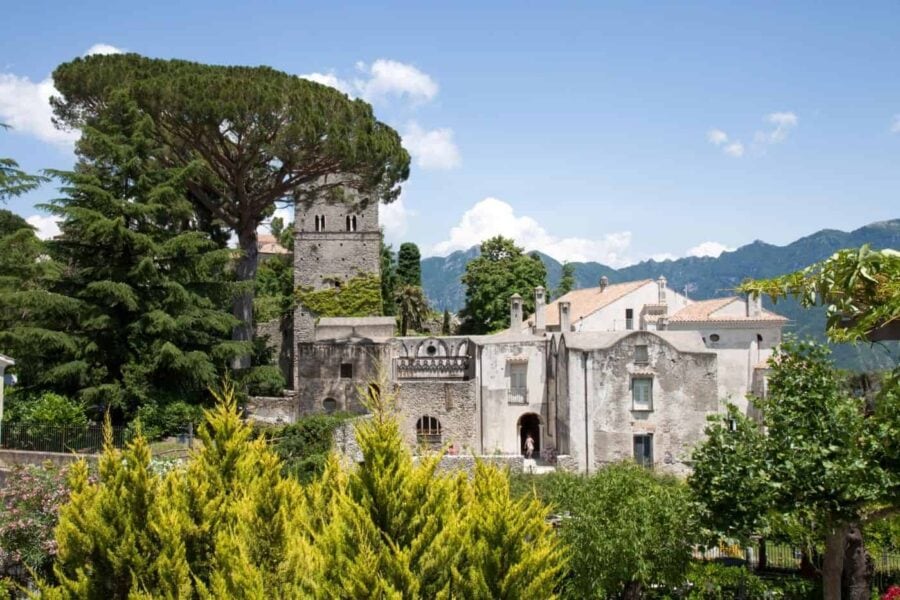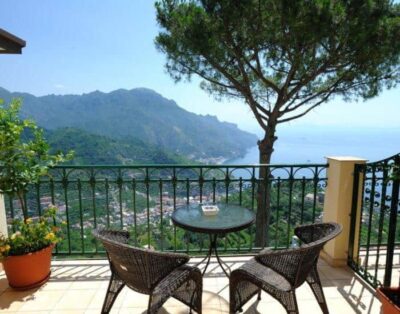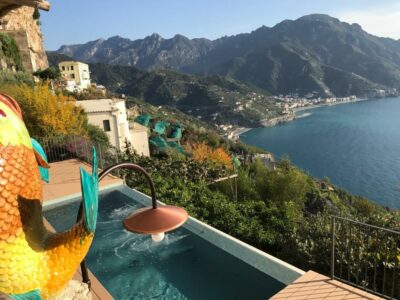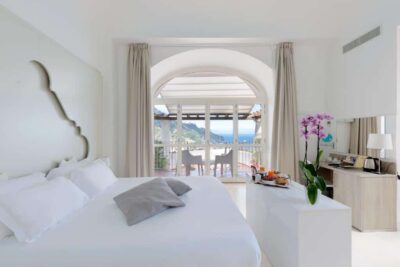Ravello is one of the most evocative destinations of the entire Amalfi Coast: a panoramic terrace offering wonderful views, but also the precious treasure chest of history and culture, sublimely told by the places and monuments we will point out to you within this article.
This most hidden village of the Amalfi Coast, set like a precious stone between the green and blue landscape, amazes for its particular atmosphere, calm, elegant and quiet: if you visit it after having stopped in the more chaotic Amalfi or in the crowded and worldly Positano, you will almost feel as if you have moved away from the Coast.
Here, in fact, tourism is more exclusive: you walk slowly through the narrow streets adorned with flowers and have a chance to appreciate the beauty of the place, which is striking for its combination of the atmosphere of the alpine landscape and its distinctly Mediterranean, colorful and fragrant gardens.
During the summer months, the town hosts the Ravello Festival, a major music event that brings the best of international and world music to the striking stage of Villa Rufolo. Hence, the appellation “City of Music.” We will talk more about this later in the section dedicated to events.
If we have intrigued you, you just have to read the whole article, where we will provide you with all the information you need to organize your vacation or day in Ravello.
Indice dei contenuti
How to Get to Ravello
📣 Ravello is located slightly inland, with the part of the coast instead occupied by the hamlets of San Cosma and Castiglione. Getting there is not the easiest, as the town is located right between Minori and Amalfi.
✅ One can arrive by car from the north, taking the Vietri Sul Mare exit and then driving up along the Cetara-Maiori-Minori route.
✅ One can also arrive by car from the South, again taking the Vietri exit and then going up the same route. On the other hand, for those who are already in Amalfi during their vacation or visit, there will only be a few kilometers to travel to this beautiful village on the Amalfi Coast.
✅ If you are traveling by bus, please note that your reference point is the town of Amalfi, from where direct buses depart to all towns on the Amalfi Coast. Travel aboard SITA SUD buses, destination “Ravello-Scala.” The trip will take about 30 minutes.
Remember to buy tickets at authorized shops (they usually display a badge with UNICO written on it). Alternatively, you can use the convenient UNICO App, which we recommend you download, to purchase your tickets wherever you are, safely and quickly.
If you are looking for more information on getting around during your trip to the Amalfi Coast, we recommend downloading our free guide “How to get around the Amalfi Coast without stress”: inside we have collected all the must-have tips for comfortable and safe travel on the Amalfi Coast.
Where to Sleep in Ravello
📣 Looking for accommodation in Ravello?
We have selected the best solutions for you!
What to See in Ravello
This beautiful terrace by the sea invites meditative walks, calm and tranquility.
Here you’ll walk among pleasant little streets that almost always lead to some scenic spot, giving you that dose of sudden amazement, which forces you to pause in order to better enjoy the present moment of beauty.
An exercise that everyday life often pushes us to procrastinate, to make room for the thousands of commitments, thoughts, and the rush to complete the eternal to-do list. But here it feels natural to stop and breathe.
After all, the allure of the City of Music has seduced numerous writers and travelers “in love with beauty” over the centuries, including Gore Vidal, who arrived in 1948 and fell in love with it to the point of never leaving. So deeply in love that he returned there six months a year.
But also enchanted were the writers of the Bloomsbory circle. And here it would be to make a very long list of names, but as a matter of convenience, we will limit ourselves to mentioning Virginia Woolf, Forster, Lawrence, who together with the others gathered at the radical coterie of Villa Cimbrone, at the court of Ernest Beckett.
All these intellectuals left traces that you will find during your walks, when your eyes rest on some plaque dedicated to one of them.
📣 Ravello will amaze you also for this: an irresistible combination of culture, beauty and poetry, not to mention the music that enlivens the summer evenings, in a location, such as villa Rufolo, that amplifies the emotions.
📍 Ravello Cathedral

one of the oldest (former) cathedrals in Italy and its first construction dates as far back as 1086. It has been subjected to additions and demolitions over the years and in its modern configuration features the extraordinary gospel abone, by Nicola di Bartolomeo da Foggia, in marble inlay and another remarkable pulpit, also in marble inlay, depicting the story of the prophet Jonah. Inside the 17th-century chapel, to the left of the chancel, is also kept the ampulla of the blood of St. Pantaleon, which just like that of St. Gennaro of Naples liquefies annually. If you would like more information about this important religious monument, we recommend reading our article dedicated to Ravello Cathedral.
Inside the Ravello Cathedral, now no longer the center of the diocese, which no longer exists, but the seat of the municipal parish, there are also two museums: The Opera Museum, in the crypt of the church, and the Medieval and Modern Art Gallery.
We advise you to visit them because they both hold important works and precious treasures: the former, in fact, collects Roman cinerary urns, reliquaries from the early Christian era and ancient artifacts; equally important is the bust of Sigilgaida Rufolo, by the same author of the Gospel Ambon; the latter, on the other hand, holds paintings from the 16th to the 19th century, collecting paintings that were present in the cathedral chapels. Important works by Francesco Messina, Giovanni Filippo Criscuolo, and Valerio Pilon.
📍 Villa Rufolo

a true jewel of Ravello. A splendid villa, outstanding architecturally and aesthetically, which contributes to a timeless beauty that has had a way of bewitching virtually everyone who has ever visited these shores. Wagner,for example, was enchanted by it and elected it as a place of refuge and meditation. The villa, which was built by the Rufolo family around the 13th century, is an immense architectural heritage that is still one of the main reasons that bring Italian and foreign tourists to Ravello.
📍 Villa Cimbrone and the Terrace of Infinity

very different from the previous one, this villa currently houses one of the most famous 5-star hotels on the Amalfi Coast. The gardens are open to outside visitors, daily from 9 am until sunset.
The gardens of Villa Cimbrone will amaze you: a plant of blue and white wisteria caps the main path, the Viale dell’Immenso, which among gardens of incredible beauty, redesigned in the 1900s with the contribution of English botany, and architecture inspired by both local buildings and Anglo-Saxon architecture, will lead you to the most exciting place of all: the marvelous Terrace of Infinity.
Here you will be suspended 365 meters above the ground, halfway between the sky and the sea: a breath of wind might give you the sensation of flying as you contemplate the landscape of the Coast all the way to Cilento. A daydream.
📍 The Coral Museum:
in Piazza Duomo you will find this private museum, curated and kept alive by Giorgio Filocamo, a coral artist. In this place dedicated to the value and beauty of this mineral, you can get up close to the art of its workmanship, accompanied by the expertise and passion of someone who has been creating works of art in coral for as many as five generations.
📍 Belvedere della Principessa di Piemonte
As you walk down Via San Giovanni del Toro, you will encounter an entrance whose arches will strike you. You will enter it, because from the outside you can see the vegetation of a small garden. Once inside, you will be in a little piece of paradise, surrounded by oak trees and flower beds, which are very well cared for. This scenic spot, from which you can enjoy the beauty of the Coast and see the medieval village of Torello, was chosen to film a scene in the movie “Beat the Devil,” starring Humphrey Bogart and Gina Lollobrigida.
📍 Church of San Giovanni del Toro
presumably founded between 975 and 1018 and consecrated in 1276, this church represented the meeting place of the Ravellian nobleness in the Middle Ages. The church has a three-nave structure, accessed through three portals, hence the larger central one. Very interesting are the Corinthian-style capitals separating the naves.
Also worth visiting is the crypt, where you can observe a pictorial cycle of the artistic climate of the 14th century, with the figure of Christ blessing in the center, around which all the saints and angels converge. Also very interesting is the ambo for the proclamation of the gospel, made in the 12th century by Alfano da Termoli. The church of San Giovanni del Toro can be visited upon request by contacting the cathedral. In summer, accessing it can be more complicated, especially during daylight hours.
What to do in Ravello
📣 There are some things you just have to do at least once in your life!
We have selected for you the best experiences in and around Ravello.
Hiking and walking
📍 Santa Barbara Trail
It is said that Palmiro Togliatti walked this path every morning that leads from the convent of the Clarisse to the medieval village of San Cosma and Damiano. It is a peaceful walk between nature and art, among rock caves, olive trees, centuries-old ferns and citrus groves. From the point of arrival there is a wonderful view from which you can glimpse picturesque Atrani, framed by the Civita and Ziro Towers.
📍 From Ravello to Amalfi or Minori
Right next to the entrance of Villa Rufolo begins Via dell’Annunziata, which passes by the Church of the Annunziata, built in 1281, whose bell towers are among the most iconic on the Coast, always immortalized by the Belvedere of Villa Rufolo.
Continuing on, one passes through the medieval village of Torello, allowing one to reach Amalfi or Minori. The route is signaled and it is impossible to take a wrong turn. The walk is pleasant and not very tiring: you descend through a series of stairs, among quiet little houses and gardens glimpsed here and there. Between one step and another, the eyes encounter wonderful and sudden views. Recommended is a stop at Torello, a characteristic and very panoramic medieval village that seems suspended in time.
📍 From Ravello to Atrani
From the Convent of Santa Chiara, which is on the way to Villa Cimbrone, take the stairs on the left, which lead to Via Santa Barbara. At the end of the stairs, turn right and then left. From here paved and paved small roads begin, until you reach the signs for “Amalfi.” From this point begins the Valle del Dragone, which was home to the ancient industrial area of Atrani, as evidenced by ruins of paper mills, mills and pasta factories that you will see on the way. On the way you will find the Church of San Michele fuori le Mura and the Church of the Carmine. From here continue toward the sea to reach the small square of Atrani.
Unmissable experiences in and around Ravello
Ravello offers no beaches, but makes up for it nicely with its splendid panoramic terraces. To reach the sea, you will have to travel by car or bus. However, this serene and tranquil town offers, as we have just seen, the possibility of slow and peaceful walks, of lazing around in contact with nature and the atmosphere of the place. In addition to enjoying moments of relaxation among the small square and various viewpoints, you can stroll through its narrow alleys, browsing its craft stores.
From here you are not far from the quaint medieval village of Scala, the oldest town on the Amalfi Coast, which we recommend you visit.
We have seen that you can also reach Minori, Amalfi and Atrani on foot, eventually returning aboard SITA SUD buses.
The nearest beach is Castiglione, not far from Atrani. If you are traveling by bus, stop at the junction and continue a few hundred meters to the staircase leading to the beach. This beach is surrounded by a high cliff and offers a beautiful view of the Bell Tower of the Church of Santa Maria Maddalena in Atrani. You can access both the free areas and the area served by a small bathing establishment, which makes for a pleasant stay.
📣 If you stay several days, treat yourself to some experiences, in our opinion, not to be missed on the Amalfi Coast: a day on a boat, the exploration of a lemon grove or a vineyard, a day exploring Capri or Sorrento. In short, enrich your itinerary, trying to bring home as many memories and emotions as you can!
Unmissable events in Ravello
✅ The Ravello Festival For more than 70 years Ravello has also become the scene of one of the most important music festivals in all of Italy. It gathers in the first week of July until usually the end of the month, with a series of outstanding classical music concerts held in the premises of the splendid Villa Rufolo, which we have mentioned before.
The program, much of which takes place inside the magnificent Oscar Niemeyer Auditorium, is particularly dense and in recent years has begun to include more modern music as well, such as concerts by the world’s best Jazz musicians, as well as selections of foreign folk music.
✅ The Torello Fire: On the third Sunday in September, immediately after the procession of Our Lady of Sorrows, a very special spectacle comes to life in the village. After a trumpet blast, fireworks are fired from the terraces of the village houses according to a well-defined program.
The show lasts over half an hour and gives the illusion that the entire village is on fire, hence the name “Fire of Torello.” The atmosphere is made even more atmospheric by the little houses illuminated by lights that change color. A unique event that we absolutely recommend if you visit Ravello and the Amalfi Coast during this period.
✅ On July 27, Ravello celebrates San Pantalone, the patron saint of the town. There is no shortage of liturgical celebrations and procession through the town, with musical accompaniment from the town band. Every year on the occasion of the feast, there is the liquefaction of the saint’s blood, an event reminiscent of the more famous liquefaction of San Gennaro’s blood in Naples.
Why choose Ravello as a travel destination
Ravello stands in a peculiar location: it is certainly a destination that is a little less easy to reach. On the other hand, this peculiarity makes the village really pleasant and quiet, very different from other iconic destinations on the Amalfi Coast.
Here you won’t find lines or crowds in the streets, nor difficulties in finding parking, because travelers are unlikely to flock there in large numbers.
📣 The quiet, relaxed and elegant atmosphere makes Ravello your ideal destination if:
🔹 you are looking for a quiet and peaceful travel destination where you can enjoy long and pleasant moments of relaxation, walks with breathtaking views and literary and artistic digressions in the wake of the many intellectuals who have stayed there;
🔹 you are not frightened by the idea of having some travel disadvantages: if you decide to visit the other towns of the Amalfi Coast on board buses, you will probably have to make more changes to reach your destination.
🔹 you want to stay in a luxury accommodation: in Ravello you are sure to find the facility that will make the perfect setting for your dream vacation.
The best time to visit Ravello
There is no best time to visit Ravello. We, as perfect locals, have visited it at different times of the year, to accompany friends and acquaintances to discover the town during their vacations. Both in the winter and summer months, the town provides a wonderful experience.
Having to express a preference, the spring season is the best: nature about to awaken, the colors beginning to explore amidst the flower beds, the scents of the Mediterranean maquis intensifying, and the blue becoming more intense, are definitely good reasons to prefer spring, not to mention the decidedly perfect climate for exploratory walks.
A small consideration deserves the journey to reach Ravello: certainly, it is more convenient to move in the off-season, that is, in early autumn or in the period between the end of winter and the beginning of spring, when the towns of the Coast and the State Road 163 Amalfitana are not yet taken by storm by the many travelers who choose it as their travel destination every year.
Alternatively, if you decide to travel during peak periods, prefer the days from Monday to Friday, since on the weekend travelers are joined by commuters who reach our towns from nearby cities, resulting in increased traffic and a greater chance of traffic jams along the road.
Interesting facts about Ravello
✅ Escher, a world-renowned engraver and graphic artist, fell in love with the Amalfi Coast, particularly Atrani and Ravello. It was here, in fact, that he met in 1923 his wife, Jetta Umiker, whom he married the following year. Among his works he portrayed the shrine of Saints Cosmas and Damian, the lion in Piazza Fontana Moresca, and the village of Torello.
✅ Ravello is extolled in Boccaccio’s Decameron, within the fourth novella, dedicated to the second day, in which the vicissitudes of Landolfo Rufolo “noble by birth, pirate by choice, castaway by fortune and, finally, by skill and good fortune happy owner of an immense treasure” are recounted.
✅ In Ravello Greta Garbo took refuge with the idea of marrying Leopold Stokowsky, the composer of the score for the Disney film Fantasia.
✅ Here Wagner composed the second act of Parsifal.
In fact, we could go on and on, mentioning all the prominent personalities who chose the town of Ravello as a stay, a refuge, a resting destination, a place to draw inspiration. Wandering around the streets of the town, you will find so many plaques dedicated to these illustrious figures.
✅ You will discover, for example, that Gore Vidal frequented Ravello for more than 30 years, becoming an honorary citizen, or that Forster, master of English literature and author of the famous “Room with a View,” wrote his first short story “A Story of a Panic” here. In short, walking through the narrow streets of Ravello is also a plunge into centuries of culture: an incredible journey through art, music and literature.
Insights: notes on the history of Ravello
Ravello was founded in the 5th century: it was the place of refuge for Romans escaping the barbarians that marked the fall of the Western Roman Empire. After all, the presence of a number of villas along the Coast, such as the Roman Villa in Minori or the one in Positano, suggest that Roman patricians favored these places as vacation destinations.
Following the founding of the Maritime Republic of Amalfi in 839, the population grew and all the towns along the Coast were united into a single Duchy.
When the Duchy of Amalfi became semi-dependent on the Norman Kingdom, the Normans gained greater control over the Amalfi aristocracy, offering support to the most influential Ravello families. Ravello slowly became very rich and impatient, until in 1086 it became an episcopal see, directly dependent on the Holy See, at the behest of Roger Guiscard.
This power was undermined by the arrival of the Pisans, on two occasions: in the first, in 1135, the enemies were stopped on Mount Brusara; in the second, in 1137, the Pisans got the better of them, destroying and sacking the city.
Economic and demographic decline began for Ravello in the early 1300s, when many local families moved their business interests to Apulia. Contributing to the decline of the old power were many internal struggles between families and disputes with nearby Scala.
The fall, slow and inexorable, continued in the succeeding centuries as many noble families, such as the famous Rufolos, moved to the city of Naples, where they held important economic and commercial positions. When the Amalfitan fief passed to the Piccolomini of Siena, Ravello was almost depopulated, except for a few noble families, who took part in the action to redeem the territory by paying 216 gold ducats demanded by Maria d’Avalos.
From the 19th century it became a coveted destination of many Grand Tour travelers, such as Wagner, Reid, Gregorovius.
From here slowly began the adventure of tourism, to which the creation and promotion of the Ravello Festival contributed, making Ravello “City of Music.”
Of the illustrious past all the monuments we have mentioned remain, but also an atmosphere steeped in old-world charm and elegance. Something that you really cannot explain and can only experience.










